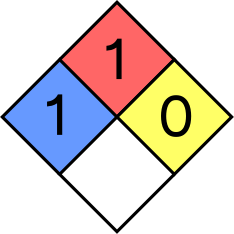GLYCEROL
Basic information
- Chemical formula(s): \({\rm C_3H_8O_3}\) (\({\rm CH_2OH-CHOH-CH_2OH}\))
- Other names: Glycerine, glycerin, 1,2,3-propanetriol
- CAS number: 56-81-5
- EC number: 200-289-5
- Molecular weight: 92.1 g/mol
- International Chemical Safety Card (ICSC): 0624
- Flammability: yes (combustible, flash point 176°C)
- Description: Hygroscopic viscous colorless liquid. Miscible with water. Generally recognized as safe (GRAS) food ingredient and pharmaceutical excipient.
NFPA 704 (fire diamond)

- Health (blue): 1 - poses no health hazard, requires no precautions, and would offer no hazard beyond that of ordinary combustible materials.
- Flammability (red): 1 - must be pre-heated before ignition can occur (flash point 176°C).
- Instability–reactivity (yellow): 0 - normally stable, even under fire exposure conditions, and is not reactive with water.
- Special notice (white): -
Hazard statements
Glycerol is not classified as hazardous under GHS regulations. However, as a combustible liquid, certain precautions apply:
| Code | Phrase |
|---|---|
| - | No hazard statements assigned (not classified as hazardous) |
Precautionary statements
Despite not being classified as hazardous, the following precautionary measures apply for combustible liquids:
| Code | Phrase |
|---|---|
| P210 | keep away from heat/sparks/open flames/hot surfaces - no smoking |
| P280 | wear protective gloves/protective clothing/eye protection/face protection |
| P370+P378 | in case of fire: use water spray, foam, dry powder, carbon dioxide for extinction |
| P403+P235 | store in a well-ventilated place, keep cool |
Protective measures
Gloves
For routine handling of glycerol:
- Any standard laboratory gloves: very good - glycerol is non-toxic and non-irritating.
- Nitrile: very good - prevents skin defatting and provides good grip.
- Natural latex or rubber: very good - adequate for normal handling.
- PVC: good - suitable for handling viscous liquids.
- Vinyl: good - adequate for food-grade applications.
Safety goggles
- Standard safety glasses recommended when handling to prevent eye contact.
- Not required for small quantities but good laboratory practice.
- Corrective glasses are not considered safety goggles.
- Eye protection particularly important due to viscous nature.
Clothing
- Standard laboratory clothing is sufficient.
- Long sleeves recommended to prevent prolonged skin contact.
- Closed-toe shoes required as standard laboratory safety.
- Hygroscopic material - may cause skin dryness with prolonged contact.
Respiratory protection
- Generally not required under normal use conditions.
- Ensure adequate ventilation when heating (produces acrolein fumes).
- Use appropriate ventilation when handling large quantities.
- Important: Heating above 176°C requires fume hood due to acrolein formation.
Spill management
- Clean up spills immediately to prevent slipping hazard (viscous liquid).
- Absorb with inert material or mop up with water.
- Fire prevention: Eliminate ignition sources during cleanup.
- Wash area with water to remove residual glycerol.
- Slippery when wet - use caution on wet surfaces.
- No special disposal requirements - can be disposed with water or as non-hazardous waste.
- Biodegradable and environmentally safe.
Special warnings
- Hygroscopic - absorbs moisture from air, may dilute over time if container not sealed.
- Combustible liquid - flash point 176°C, auto-ignition temperature 393°C.
- Heating hazard - produces toxic acrolein fumes when heated above decomposition temperature.
- Generally recognized as safe (GRAS) - approved food ingredient and pharmaceutical excipient.
- Skin drying - prolonged contact may cause dry skin due to hygroscopic properties.
- Laxative effect - ingestion of large quantities may cause diarrhea.
- Store in tightly closed containers to prevent moisture absorption.
- Incompatible with strong oxidants - may cause fire and explosion risk.
- Keep away from heat sources when stored.
- Slippery - clean up spills immediately to prevent falls.
- Explosive limits in air: 2.6-11.3 vol% (when heated to form vapor).